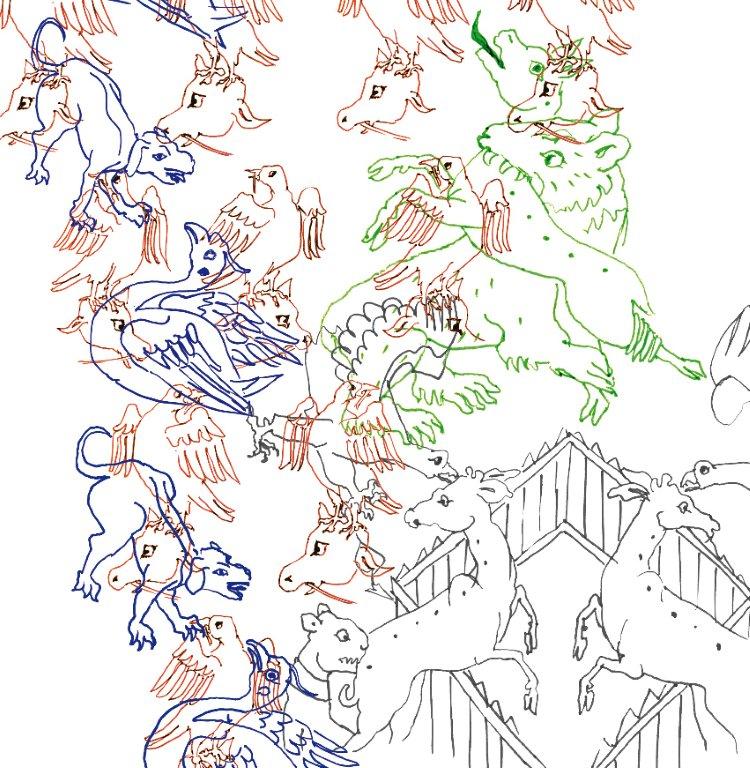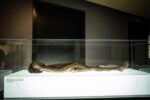Judith Raum – Disestablish

Judith Raum attraverso la lente dell’industria tessile analizza a Lucca, nel quartiere dei Guinigi – una delle grandi corporation del tempo – lo sviluppo precoce delle prime strutture economiche da cui nasce il capitalismo.
Comunicato stampa
JUDITh RAUM
disestablish
In Europe of the Middle Ages, Lucca was the most important center for silk industry.
Companies from Lucca, such as the Guinigi, were engaged in international
commercial and banking activities, reaching as far as the Orient and Northern
Europe. They nanced the Crowns of England, France and Burgundy. Upon the
death of the Duke of Burgundy, a merchant from Lucca was appointed for the
funeral from Hal to Dijon and along the entire route of the funeral procession,
churches were decorated with black drapes carrying golden braiding from Lucca.
With her presentation at Pavillon, located in direct neighborhood of the Guinigi (one
of the largest corporations of the past), Judith Raum, through the lens of the textile
industry in Lucca, looks at the early development of the rst economic structures
from which capitalism originated.
Silk and textile industry in general were the most important elds of production. At
the time, commercial and nancial activities of global scale were linked to local
structures of production and politics based on the exploitation of both subordinate
and artisan labour. However, it was not in Lucca but in Florence that in 1378 the
rst revolt of textile workers took place. In the Revolt of the Ciompi (from the word
ciompo or beggar) the workers of the wool industry claimed their right to associate in
unions, demanding true political representation and cancellation of debts.
The workers from Lucca would revolt two centuries later, around the May 1th 1531.
When the ruling classes unloaded the costs of a nancial crisis on the workers and
their families, the workers stood up under the banner of a tattered black fabric –
again a fabric. The Revolt of the Ciompi stems from this historical incident. Among
the demands of the Ciompi was the abolition of the controller, or checker – which
can be associated with the ordered structure of a checkerboard grid. For the title of
her show, Judith Raum reduced disestablish the checker to disestablish. In her earlier
works, the artist has explored the relationship between Germany and Turkey in the
nineteenth century and the German nancial imperialism linked to the construction
of the Ottoman Railway, used as a bridgehead for economic and business development.
For example, German textile products were sold in Anatolia as local products.
The railroad was the instrument used to colonialize space and minds (among other
material and immaterial tools such as the work organization, the strive for prot,
functionality, eciency, etc.). It created the framework for a molding of the local
landscape and its inhabitants into the new global economic outlook.
In her first solo show in Italy, Judith Raum shows large, white, silkscreen-printed
fabrics as well as paintings with depictions of ghts between animals, taken from
sumptuous silks of fourteenth century Lucca. Conicts, hunting scenes, predators
and prey, dominated and subjugated. Presented in combination with works on paper,
research material, texts and writings by Niccolò Rodolico on the Revolt of the Ciompi,
the fabrics become precusors of modern political banners.
Judith Raum, Germany, 1977, lives and works in Berlin - www.judithraum.net
JUDITh RAUM
disestablish
Nell’Europa del Medioevo Lucca era il centro di produzione più importante
nell’industria della seta. Le compagnie lucchesi, come quella dei Guinigi, disponevano di ramificazioni commerciali e bancarie dall’Oriente al Nord Europa. Finanziavano le Corone di Inghilterra, Francia e Borgogna. Alla morte del Duca di Borgogna fu un mercante lucchese incaricato del trasporto funebre da Hal a Digione e lungo l’intero percorso del corteo le chiese vennero addobbate con drappi neri lucchesi dagli orli d’oro.
Judith Raum attraverso la lente dell’industria tessile analizza a Lucca, nel quartiere
dei Guinigi - una delle grandi corporation del tempo - lo sviluppo precoce delle prime
strutture economiche da cui nasce il capitalismo. L’industria della seta e in genere il tessile era il settore più importante per la produzione di valore. Alle attività mercantili e finanziarie si intrecciava un’organizzazione politica e produttiva interna basata sulla dipendenza e lo sfruttamento del lavoro artigiano e subordinato. Ciò nonostante non è a Lucca ma a Firenze che ha luogo, nel 1378, la prima rivolta dei lavoratori tessili. Con il Tumulto dei Ciompi (da ciompo: pezzente) gli operai del settore
laniero rivendicano il diritto di associarsi in corporazione, chiedendo rappresentanza politica e la cancellazione del debito verso i datori di lavoro. Gli operai lucchesi si rivoltarono due secoli più tardi, attorno al primo maggio 1531. Allorché le classi dirigenti scaricarono i costi della crisi sui lavoratori e le famiglie, questi si sollevarono all’insegna di un logoro drappo nero - ancora una volta una stoffa - da cui l’appellativo di Rivolta degli Straccioni.
Nei suoi lavori precedenti l’artista ha indagato i rapporti Germania-Turchia nell’Ottocento e l’imperialismo finanziario tedesco legato alla costruzione della Ferrovia Ottomana, usata come testa di ponte per finalità economiche e commerciali. Prodotti tessili tedeschi venivano venduti in Anatolia, ad esempio, come prodotti locali. La ferrovia era lo strumento (tra altri strumenti materiali e immateriali di colonizzazione su spazio e menti, quali ad esempio il telaio, l’organizzazione del lavoro, logica del profitto, funzionalità, efficienza, etc.) che rendeva possibile la plasmazione
del paesaggio locale e dei suoi abitanti alla nuova visione economica globale.
In Disestablish (destabilizzare, destituire), prima personale in Italia da Pavillon,
Judith Raum, presenta materiale d’archivio, testi e grandi tessuti bianchi serigrafati e dipinti con raffigurazioni di animali in lotta, araldici e sontuosi, derivanti da sete lucchesi trecentesche. Conflitti, cacce, predatori e prede, dominati e soggiogati.
Judith Raum, tedesca, 1977, vive a lavora a Berlino - www.judithraum.net



